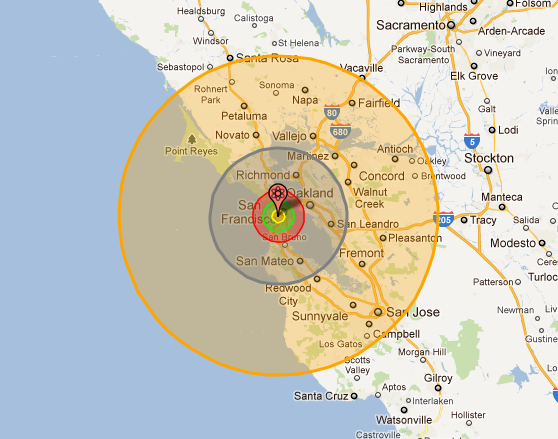In most parts of the world, fears of a nuclear war fell along with the Soviet Union around the start of the 1990s. But one website lets you see what the effect of a nuclear bomb would be anywhere in the world, the Daily Mail reports.
The NUKEMAP, created by Alex Wellerstein, uses Google Maps to pick any Ground Zero you like in the world.
Wellerstein, who holds a Ph.D. in the history of science from Harvard, is a historian of science at the American Institute of Physics. He says using the site in his classes helps students understand what nuclear weapons are all about.
You can from pick a list of cities from a drop-down menu, or stick a pin in the map. The site will attempt to detect your location and use that as Ground Zero
You can also enter the yield of the bomb in kilotons or again pick from a list of weapons, from the “Davy Crockett,” the smallest nuclear warhead the U.S. has produced (20 tons) to the Soviet “Tsar Bomba,” the largest bomb ever designed, weighing in a 100 megatons. (The engineers actually building the thing chickened out and only tested a bomb with half the proposed yield.)
With your weapon and target selected, you can finally detonate the nuke. You’ll see a series of circles emanating from the target, showing the kind of damage certain areas would get. First, there’s the actual fireball, then the areas where building would be toppled by the blast wave, the radius of the initial radiation effects, the air blast radius, and finally the area where people would get third-degree burns and firestorms could start. The bigger the bomb, the bigger the areas, obviously.
Here’s the Tsar Bomba as designed detonated over San Francisco:
You can see how it would devastate the whole Bay Area. I also played around with a “limited” nuclear exchange, lobbing much smaller tactical warheads at places like airports, refineries, and an Air Force base, and the region doesn’t fair much better.
Visualizing the effects of nuclear bombs seems to drive home how dangerous they really are, even though the risk of an all-out nuclear conflagration is a lot less than it used to be. But the American and Russian nuclear arsenal didn’t go away after the fall of the Iron Curtain, China still has nuclear weapons, and both India and Pakistan have tested nuclear bombs. And that’s not even counting potential nuclear terrorism (NUKEMAP has a hypothetical low-yield terrorist bomb, a situation everybody wants to stay hypothetical).
If this site doesn’t make you join the peace movement, then nothing will. Its creator maintains that its purpose, however, is completely apolitical even though NUKEMAP is popular with anti-nuclear activists. “They like it because it highlights the danger they create. I’m sort of in the middle on all this so I don’t see it as having a particular message,” Wellerstein told the Daily Mail.
You Might also like a vintage atomic energy kit from the 1950s that contained real uranium. If all this nuclear talk’s got you down, then why not check out a pinhole variation of the Hasselblad camera, which the astronauts used to take pictures of the other major scientific achievement of the 20th Century, the Moon landings.











